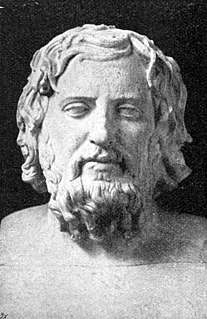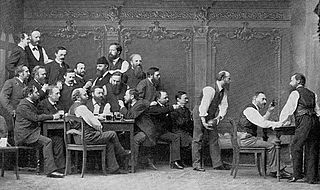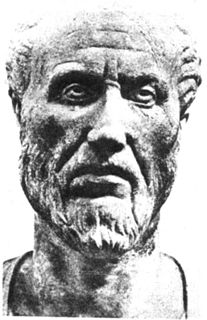
Pseudo-Dionysius the Areopagite, also known as Pseudo-Denys, was a Christian theologian and philosopher of the late 5th to early 6th century, who wrote a set of works known as the Corpus Areopagiticum or Corpus Dionysiacum.

Zeno of Citium was a Hellenistic thinker, of Phoenician descent, from Citium, Cyprus. Zeno was the founder of the Stoic school of philosophy, which he taught in Athens from about 300 BC. Based on the moral ideas of the Cynics, Stoicism laid great emphasis on goodness and peace of mind gained from living a life of Virtue in accordance with Nature. It proved very popular, and flourished as one of the major schools of philosophy from the Hellenistic period through to the Roman era.

Arrian of Nicomedia was a Greek historian, public servant, military commander and philosopher of the Roman period.
Chariton of Aphrodisias was the author of an ancient Greek novel probably titled Callirhoe, though it is regularly referred to as Chaereas and Callirhoe. Recent evidence of fragments of the text on papyri suggests that the novel may have been written in the mid 1st century AD, making it the oldest surviving complete ancient prose romance and the only one to make use of apparent historiographical features for background verisimilitude and structure, in conjunction with elements of Greek mythology, as Callirhoë is frequently compared to Aphrodite and Ariadne and Chaereas to numerous heroes, both implicitly and explicitly. As the fiction takes place in the past, and historical figures interact with the plot, Callirhoe may be understood as the first historical novel; it was later imitated by Xenophon of Ephesus and Heliodorus of Emesa, among others.
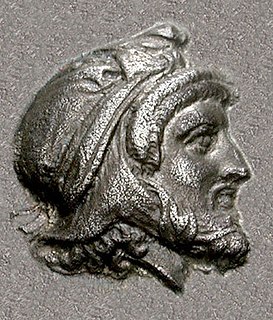
Pharnabazus II was a Persian soldier and statesman, and Satrap of Hellespontine Phrygia. He was the son of Pharnaces II of Phrygia and grandson of Pharnabazus I, and great-grandson of Artabazus I. He and his male ancestors, forming the Pharnacid dynasty, had governed the satrapy of Hellespontine Phrygia from its headquarters at Dascylium since 478 BC. He married Apama, daughter of Artaxerxes II of Persia, and their son Artabazus was likewise a satrap of Phrygia.

Xenophanes of Colophon was a Greek philosopher, theologian, poet, and social and religious critic. Xenophanes lived a life of travel, having left Ionia at the age of 25 and continuing to travel throughout the Greek world for another 67 years. Some scholars say he lived in exile in Sicily. Knowledge of his views comes from fragments of his poetry, surviving as quotations by later Greek writers. To judge from these, his elegiac and iambic poetry criticized and satirized a wide range of ideas, including Homer and Hesiod, the belief in the pantheon of anthropomorphic gods and the Greeks' veneration of athleticism. He is the earliest Greek poet who claims explicitly to be writing for future generations, creating "fame that will reach all of Greece, and never die while the Greek kind of songs survives."

Aspasia was an influential immigrant to Classical-era Athens who was the lover and partner of the statesman Pericles. The couple had a son, Pericles the Younger, but the full details of the couple's marital status are unknown. According to Plutarch, her house became an intellectual centre in Athens, attracting the most prominent writers and thinkers, including the philosopher Socrates. There are also suggestions in ancient sources that the teachings of Aspasia influenced Socrates. Aspasia is mentioned in the writings of Plato, Aristophanes, Xenophon, and others.

The Sacred Band of Thebes was a troop of select soldiers, consisting of 150 pairs of male lovers which formed the elite force of the Theban army in the 4th century BC. Its predominance began with its crucial role in the Battle of Leuctra in 371 BC. It was annihilated by Philip II of Macedon in the Battle of Chaeronea in 338 BC.

Iamblichus was a Syrian Neoplatonist philosopher of Arab origin. He determined the direction that would later be taken by Neoplatonic philosophy. He was also the biographer of Pythagoras, a Greek mystic, philosopher and mathematician.

The Socratic problem is a term used in historical scholarship concerning attempts at reconstructing a historical and philosophical image of Socrates based on the variable, and sometimes contradictory, nature of the existing sources on his life. Scholars rely upon the extant sources such as those of contemporaries like Aristophanes or disciples of Socrates like Plato and Xenophon for knowing anything about Socrates. However, these sources contain contradictory details of his life, words, and beliefs when taken together. This complicates the attempts at reconstructing the beliefs and philosophical views held by the historical Socrates. It is apparent to scholarship that this problem is now deemed a task seeming impossible to clarify and thus perhaps now classified as unsolvable.
Simon the Shoemaker was an associate of Socrates, and a 'working-philosopher'. He is known mostly from the account given in Diogenes Laërtius' Lives and Opinions of Eminent Philosophers. He is also mentioned in passing by Plutarch and Synesius; a pupil of Socrates, Phaedo of Elis, is known to have written a dialogue called Simon.
On Horsemanship is the English title usually given to Περὶ ἱππικῆς, peri hippikēs, one of the two treatises on horsemanship by the Athenian historian and soldier Xenophon. Other common titles for this work are De equis alendis and The Art of Horsemanship. The other work by Xenophon on horsemanship is Ἱππαρχικὸς, hipparchikos, usually known as Hipparchicus, or The cavalry commander. The title De re equestri may refer to either of the two.
Geoponici, or Scriptores rei rusticae, is a collective term for the Ancient Greece and Ancient Rome writers on husbandry and agriculture. In classical times it was regarded as a branch of economics. On the whole the Greeks paid less attention than the Romans to the scientific study of these subjects.
Aeschines of Sphettus or Aeschines Socraticus, son of Lysanias, of the deme Sphettus of Athens, was a philosopher who in his youth a follower of Socrates. Historians call him Aeschines Socraticus—"the Socratic Aeschines"—to distinguish him from the more historically influential Athenian orator also named Aeschines. His name is sometimes but now rarely written as Aischines or Æschines
In ancient Greece the chief magistrate in various Greek city states was called eponymous archon. Archon means "ruler" or "lord", frequently used as the title of a specific public office, while "eponymous" means that he gave his name to the year in which he held office, much like the Roman dating by consular years.
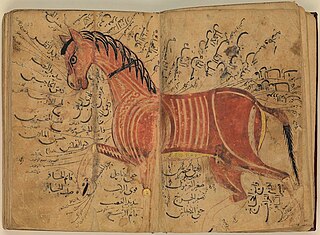
Furūsiyya is the historical Arabic term for equestrian martial exercise.

Socrates was a classical Greek (Athenian) philosopher credited as one of the founders of Western philosophy, and as being the first moral philosopher, of the Western ethical tradition of thought. An enigmatic figure, he made no writings, and is known chiefly through the accounts of classical writers writing after his lifetime, particularly his students Plato and Xenophon. Other sources include the contemporaneous Antisthenes, Aristippus, and Aeschines of Sphettos. Aristophanes, a playwright, is the only source to have written during his lifetime.
Hipparchicus is one of the two treatises on horsemanship by the Athenian historian and soldier Xenophon (circa 430–354 BC). Other common titles for this work include The cavalry commander and The cavalry general. The other work by Xenophon on horsemanship is Περὶ ἱππικῆς, Perì hippikēs, usually translated as On horsemanship, De equis alendis or The Art of Horsemanship. The title De re equestri may refer to either one of the two works. Hipparchicus deals mainly with the duties of the cavalry commander (hipparchus), while On horsemanship deals with the selection, care and training of horses in general.

The biga is the two-horse chariot as used in ancient Rome for sport, transportation, and ceremonies. Other animals may replace horses in art and occasionally for actual ceremonies. The term biga is also used by modern scholars for the similar chariots of other Indo-European cultures, particularly the two-horse chariot of the ancient Greeks and Celts. The driver of a biga is a bigarius.


